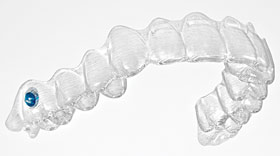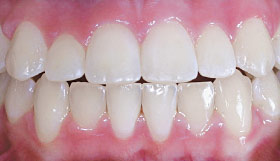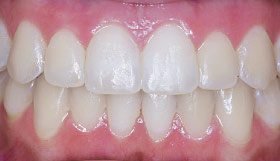Clear Aligners for Teenagers
User-Friendly Orthodontics
(Continued)
New And Improved Aligners — Customized For Teens
Imagine, if you will, a stick poking up from a small hill of sand; let's say that stick represents a tooth. To move the stick, you could “tip” it in one direction, backwards, forwards or sideways, without changing the position of the bottom of the stick, in other words moving the stick in one plane only (2D – two dimensions of space). That's what clear aligners were initially designed to do. Now, with the addition of tiny “power ridges” and other barely visible specialized features that apply more controlled and efficient force, they can move teeth in 3D (three dimensions), i.e. not only tipping the stick backward, forward or sideways, but also dragging the stick bodily through the sand. In the real life situation this equates to moving a tooth root bodily through bone to line it up.
In the beginning, clear aligner appliances were successful in limited 2D movements of the teeth in one plane, realigning or straightening them, closing mild spaces, treating elongated and tipped teeth into better position. The system was recommended if the bite was “normal” — meaning the back teeth already fit together properly. With a normal bite, biting forces distribute evenly on all of the teeth, which also protects the health of the supporting periodontal structures (“peri” – around; “odont” – tooth), the gums and bone. With an abnormal or bad bite, forces are uneven, creating uneven wear and instability of the position of the teeth.
Today, the enhanced system features aligners made from a thinner more comfortable material, and the interval for changing each set of aligners can be modified to be every 7 or 10 days, or the customary 2 weeks. Along with these changes has come the product's ability to achieve more predictable tooth movement, which helps when treating even teenagers with malocclusions where the only prior choice may have been traditional braces.
 |
| Colored compliance indicators motivate teenagers to be more responsible for wearing their aligners. |
In fact, the treatment of teens with the clear aligner system has changed considerably in the past several years. For example, teens were normally not considered good candidates for this system because their second molars (the last to come in, except for the wisdom teeth) had not fully grown into position. Clear aligners now have “eruption tabs” that serve as space-holders for teeth that have not yet fully erupted.
Teens also were generally not considered good candidates for this system because it was assumed they would not be as conscientious as adults about wearing the aligners. Clear aligners for teens now have colored compliance indicators built into the aligner material that fade with time as each aligner is worn. These indicators allow dentists, parents, and teens alike to monitor both compliance with a teen's planned treatment program and progress, and to modify treatment accordingly.
Better Than Braces — In The Right Cases
Being able to examine the specific movement patterns for all teeth in detail on the computer is a tremendous advantage. Your teen's orthodontist or dentist can simulate different treatment scenarios and determine which is best. The teen can then see the progressive outcomes of his or her customized treatment plan on the computer screen before making any final decisions on whether or not to proceed.
 |
| A photograph before treatment showing a bite that is not ideal. |
 |
| A photograph after treatment with clear aligners, showing a more ideal bite. |
| Photos provided by Dr. Gary Brigham |
In mild anterior open-bite situations — where the front upper and lower teeth do not meet or contact each other (from eyetooth to eyetooth in both upper and lower jaw) — clear aligner treatment is especially advantageous. The material covering the posterior (back) teeth exerts pressure in conjunction with the individual's natural biting force, while the attachments to the anterior (front) teeth are effective in closing the open bite. This situation is more difficult to treat with traditional braces.
In addition, teens who have clenching or grinding habits, which can lead to excessive wear and tear on their teeth, can benefit from using clear aligners while they sleep. In these cases, the aligners also serve as thin nightguards. This can reduce the discomfort (to facial muscles and surrounding tissues) caused by these unconscious habits.
Your Doctor Is Your Best Guide
Orthodontics using clear aligners is not for every teen, and its application will depend on each individual's situation. An orthodontist is in the best position to analyze difficult malocclusions to determine a teen's candidacy, and to take into account how predicted jaw growth and development will impact treatment.
Malocclusions can be caused by discrepancies not only in tooth position, but also in jaw alignment. In some of these cases, auxiliary treatment incorporating elastics (rubber bands) and/or expansion appliances may be used in conjunction with aligners, just as in traditional orthodontic treatment. In more severe cases, traditional orthodontic braces may offer more control of tooth movement, and in addition jaw surgery may be needed to improve tooth alignment, function and facial aesthetics.
In addition to a teenager's compliance with the treatment program, the orthodontist's (or dentist's) expertise with clear aligners can significantly impact the outcome. Clear aligner treatment has only recently been taught in selected dental schools, and is still considered a relatively new treatment system. Therefore, orthodontists who have the most success using clear aligners are usually the ones who have gained extensive clinical experience treating mild malocclusions before tackling more complex cases with these appliances. It would be prudent to find out how many cases a dentist or orthodontist you are considering has treated with this system.
Orthodontics using clear aligners is not for every teen, and its application will depend on each individual's situation.
Clear Aligners As The 21st Century Solution
Clear aligners represent a whole new spin on high-tech orthodontic treatment for the 21st century teen. Orthodontists who have embraced this technology, which has evolved to better suit the needs of contemporary teens, are using it to more fully engage young people in their own treatment by involving them in the monitoring of their progress. Because the pressure applied to the teeth with these custom aligners can be modified, teens can actually control the pace and comfort level of their treatment according to their individual sensitivity and activity. More importantly, they are given an opportunity to make their own choices on their own schedules.
Clear aligners can positively impact a teen's capacity to function normally and in a socially acceptable way during a difficult and transitional phase of life.



